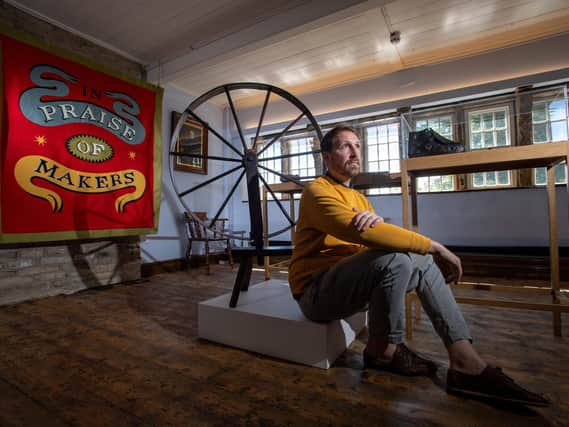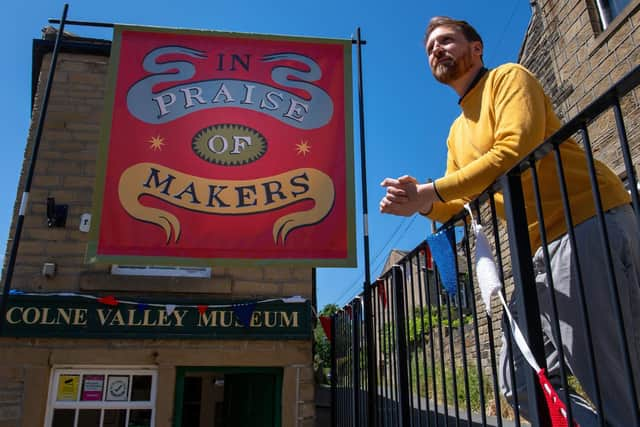Artist Ed Kluz on his collaboration with Colne Valley Museum near Huddersfield


A new exhibition opened earlier this month at the Colne Valley Museum in Golcar, Huddersfield showcasing work by artist, illustrator and printmaker Ed Kluz, celebrating the history of the museum and the traditional skills and techniques it is helping to preserve. The collaboration is part of the Arts Council-funded Meeting Point Programme, led by contemporary arts agency Arts&Heritage.
It has brought together leading artists with six museums in Yorkshire, the North-West and the North-East to produce new artworks in response to the museums and their collections. It is a fruitful scheme for both sides involved – for the museums and heritage sites it is an opportunity to look at their collections afresh and to get a new perspective on them from a creative outsider, and for the artists it is a chance to perhaps push themselves out of their comfort zone, to find new ways of creating work.
Advertisement
Hide AdAdvertisement
Hide AdKluz was one of the artists taking part in the third edition of the Meeting Point Programme, who were invited to listen to presentations from the selected museums, one of which was Colne Valley Museum. “When I went along, I wasn’t quite sure what to expect,” he says. “There were a number of museums involved but the Colne Valley Museum really spoke to me because I really bought into this idea that it was a living museum not only in its concept but also in its working methods. It is entirely volunteer-run and it’s been going for 50 years; I thought there was an amazing story behind the museum and I liked the fact that the volunteers were so ambitious and so passionate about what they do.”


Last year the museum received recognition for its work and the contribution its volunteers make to the local community when it was awarded the Queen’s Award for Voluntary Service. Kluz was immediately struck by the wealth of talent that the volunteers represented. “They are all specialists in their own field – there are people who have been working in the textile industry in Huddersfield for years – and I just love the idea of a group of individuals making this happen and that the museum is a really important educational tool. There was this incredible group of people who have this amazing pool of skills and as an artist I really wanted to engage with that.”
From the museum’s perspective, it was delighted with Kluz’s approach – which, says lead volunteer curator Melanie Williams, made him stand out from the other artists who had submitted expressions of interest. “When he came to meet us, it was clear from the questions he was asking that he understood what we were about,” she says. “There is a great pride in this area in the Luddite history and in self-sufficiency. He immediately got that and he recognised the immense skill set that was already in the museum. It was very much about how we could work together in collaboration. Then he started visiting the museum on a regular basis to get a feel for the building and to talk to the people working there – and then we let him loose on the collection.”
The museum is housed in four cottages dating back to the 1840s built by a family of independent cloth manufacturers, the Pearsons. Its purpose is to preserve the buildings and the traditional skills which were practised there during the 19th century and to celebrate the craft heritage of the valley as a whole in that period. The museum’s collection is divided into six main categories: textile, domestic artefacts, costume, clog-making, a political collection and several photographic collections. Kluz set about exploring the collection and engaging with the museum volunteers.
Advertisement
Hide AdAdvertisement
Hide Ad“There is a strong sense of pride and quiet power in the museum community and I wanted to underline the similarities in the way this cottage industry thrived here before the mass mechanisation of the mills,” he says. “And that also maybe has a resonance today in the way we are changing our working practices at the moment and how there is a bit of a boom in the creative industries making at home. There is a return to the home-based maker.” Kluz’s wish to celebrate that led to the exhibition’s title and the creation of its centrepiece – a banner made out of red cloth woven at the museum and embroidered with the words “In Praise of Makers”.
The Colne Valley has a long association with radical Socialist politics – the Luddites, Chartists and Suffragettes all had a strong presence in the area, and this legacy was something that Kluz was also keen to incorporate into the exhibition. “That strong Socialist history and the link with those radical movements is reflected in the museum’s collection – I found a fantastic Suffragette medal and these wonderful ceramics with Socialist mottos on them – and it was a story I wanted to bring out. I wanted to look at the less obvious and more difficult histories and tackle them in a visual way. It was a careful process of reading the landscape of the museum, finding a way of engaging rather than imposing my ideas as an artist and listening to how the volunteers wanted the museum to be reflected.”
He did a lot of work with the women who are part of the museum’s textile group. “I was really drawn to their work and could see their beautiful understanding of material,” he says. “I met with them a couple of times and we talked about 19th century religious samplers and embroidery and how so much of that work was in the hands of women and girls at that time. You would get girls as young as seven making samplers that dealt with morality and mortality, and being God-fearing. It was interesting because there was all this radical politics and activism on the one hand and then this more nuanced feminine work on the other.”
Out of Kluz’s discussions with the craft and textile group members, a series of intricate needleworks showcasing mottos from the early 18th and 19th centuries has been created. Also featured in the exhibition is a 19th century display cabinet. “It is filled with ceramics from the museum collection – some commemorating political events and others with more generic maxims on them. Alongside those are new pieces I have made, vessels which have activist slogans on them and speak of the radical political history of the Colne Valley.”
Advertisement
Hide AdAdvertisement
Hide AdFor the museum volunteers and everyone involved, the collaboration with Kluz has been extremely positive. “It has been really helpful,” says Williams. “Because it has made us think about what we are doing in a different way, about how we can draw in a wider audience and be more inclusive and what we need to do to ensure that we are sustainable in the future. We have been completely blown away by the artworks Ed has produced – they really reflect what we are trying to do.”
For Kluz too, it has been a rich and fascinating experience. “I have found it really inspiring and humbling. I have learnt an awful lot about embroidery and I have also really enjoyed the personal interactions. We have become friends over the past two-and-a-half years – the project was longer than we expected because Covid put things on hold. I have loved every minute of it, particularly being able to work with such an incredible set of people. It has been so rewarding and I am hoping it will evolve into something bigger and ongoing.”
In Praise of Makers runs at the Colne Valley Museum until October 4. It is open Saturdays, Sundays and Bank Holiday Mondays, 11am to 5pm. colnevalleymuseum.org.uk
Comment Guidelines
National World encourages reader discussion on our stories. User feedback, insights and back-and-forth exchanges add a rich layer of context to reporting. Please review our Community Guidelines before commenting.